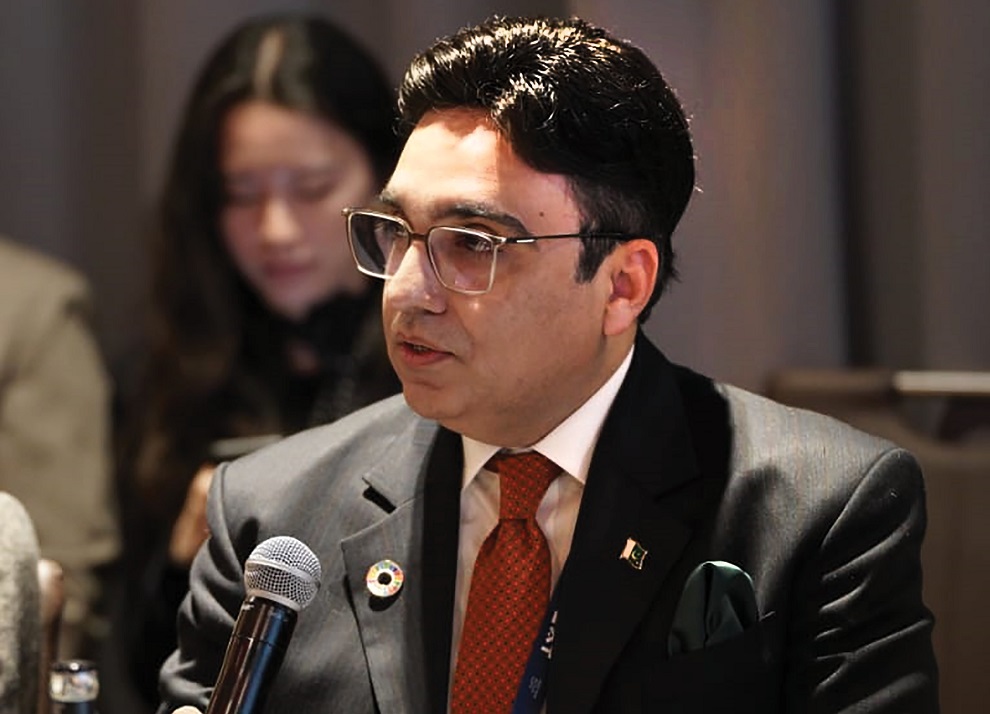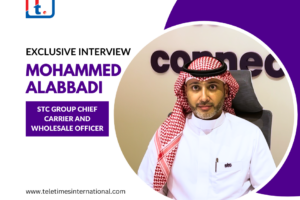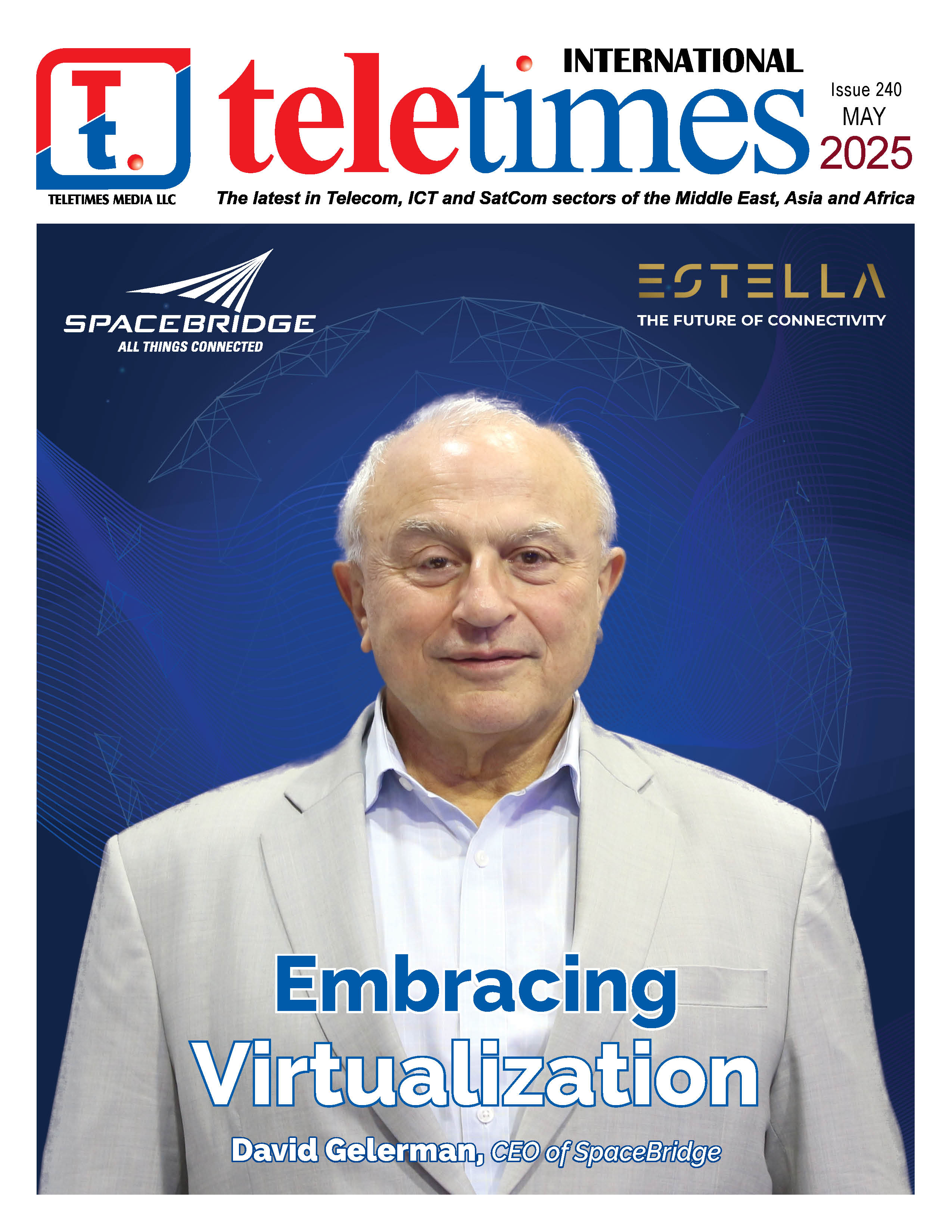Chaudhry Mudassar Naveed, CEO of Universal Service Fund Pakistan, speaks to Teletimes International at MWC 2025 Barcelona
| Chaudhry Mudassar Naveed, a seasoned telecom professional, currently serves as the CEO of USF Pakistan. With over 24 years of industry experience, his expertise spans government policy, regulation, technology business growth, and digital transformation. Mudassar’s career includes pivotal roles in spectrum management, cellular design, project execution, and corporate strategy. He has collaborated with industry leaders like Ericsson, and Nortel Networks, and operators such as Telenor and PTCL Group. At the Pakistan Telecommunication Authority, Mudassar served as DG (Strategy & Development), where he introduced key initiatives including the IoT & SRD Regulatory Framework, infrastructure sharing framework, and the adoption of the next generation of Wi-Fi 6E & 7 in Pakistan. Mudassar holds a BS and MS in Electrical Engineering, an MBA, and is an alumnus of Carnegie Mellon University’s Center for Executive Education in Technology Policy. He is dedicated to significantly contributing to Pakistan’s journey toward digital transformation and enhanced connectivity through his robust expertise. He held the Chair of APT South Asian Telecom Regulators’ Council (SATRC) Working Group – Policy, Regulation & Services (WG-PRS) during 2021-23 in which Action Plan VIII was executed. Mudassar represented Pakistan at the ITU World Radio Conference (WRC-23). He is also a regular speaker at both international and national events, where he shares his insights on the latest trends and advancements in the telecom industry. |
Khalid Athar: Can you give us an overview of USF Pakistan’s mission and role in the country’s digital landscape?
Mudassar Naveed: Universal Service Fund (USF) Pakistan is dedicated to bridging the digital divide by expanding broadband connectivity and digital services to underserved and unserved areas across Pakistan. Our mission is to create an inclusive digital ecosystem by facilitating access to high-speed internet, digital literacy, and e-services for communities, schools, and businesses in rural and remote regions. USF plays a pivotal role in driving Pakistan’s digital transformation by ensuring equitable access to connectivity, promoting socio-economic growth, and supporting the government’s vision of a Digital Pakistan.
KA: How has USF contributed to digital inclusion, especially in rural and remote areas?
MN: USF has successfully deployed broadband infrastructure in the remotest of areas, benefiting millions of Pakistanis who previously lacked internet access. Our key initiatives include:
• Broadband for Sustainable Development: Expanding high-speed internet to unserved and underserved areas, ensuring that communities in remote regions have reliable access to digital services, enabling local businesses, e-learning, and telehealth solutions.
• Next-Generation Broadband: Strengthening and extending fiber-optic connectivity to improve network capacity, allowing seamless 4G and future 5G expansion. This initiative enhances internet speed, reduces latency, and supports emerging technologies such as smart city applications and AI-driven services.
• Telecom Infrastructure Projects: Developing and reinforcing telecom networks in remote, rural, and disaster-prone areas, ensuring connectivity during emergencies, ensuring that critical communication remains uninterrupted.
• Gender Digital Inclusion: Promoting digital literacy and financial empowerment for women and marginalized communities by increasing access to mobile broadband, enabling them to utilize and benefit from eHealth, eFinance, e-commerce facilities. This initiative encourages greater female participation in the digital economy, promoting online entrepreneurship and financial independence.
• Smart Schools & Digital Skills: Enabling digital education and skill development to enhance employability
These efforts have significantly contributed to the expansion of economic opportunities, remote education, telemedicine, and digital financial services in rural communities, creating a more inclusive and connected Pakistan.
KA: USF has played a pivotal role in bridging the digital divide in Pakistan. Could you give us an overview of its journey, key projects, and the tangible impact it has made on the country’s digital landscape?
MN: Universal Service Fund (USF) has been at the forefront of Pakistan’s digital transformation, ensuring that the benefits of connectivity reach even the most remote and marginalized communities. Since its inception, USF has launched over 161 projects, expanding broadband access to underserved regions. Our work has successfully delivered high-speed broadband to over 37 million people, deployed 16,742 km of optical fiber, and provided connectivity to 21,000+ mauzas (hamlets). Additionally, we have established 4,400+ telecom sites, ensuring digital inclusion across Pakistan.
“Connectivity must translate into economic empowerment, access to education, and improved healthcare. Our projects have facilitated e-learning for students in remote areas, expanded telemedicine services, and enabled small businesses to access digital marketplaces.”
However, infrastructure alone is not enough. Connectivity must translate into economic empowerment, access to education, and improved healthcare. Our projects have facilitated e-learning for students in remote areas, expanded telemedicine services, and enabled small businesses to access digital marketplaces. By prioritizing connectivity for all, we are not only bridging the digital divide but also creating new opportunities for socio-economic growth. The vision is to make broadband a catalyst for development, positioning Pakistan as a digital-first economy.
KA: What are the biggest challenges USF faces in implementing its projects, and how do you overcome them?
MN: Some of the major challenges include:
• Geographical Barriers: USF faces significant infrastructure deployment challenges due to the predominantly rugged terrain of its operating regions, including Balochistan and Gilgit-Baltistan. These areas feature hilly, mountainous, desert, and barren landscapes, making access and work difficult.
• High Deployment Costs: Remote connectivity requires significant investment. We work with industry players and international development partners to secure funding.
• Policy & Regulatory Framework: Aligning regulations with emerging technologies is crucial. We work closely with the Pakistan Telecommunication Authority (PTA) and the Ministry of IT & Telecom to refine policies that support sustainable digital expansion.
• Energy Constraints: Many rural areas lack reliable electricity, affecting telecom infrastructure. We are exploring renewable energy solutions to sustainably power telecom sites – 93% of USF sites in Pakistan are now solar powered.

KA: Given USF’s mandate to bridge the digital divide, how can telecom operators collaborate more effectively with your initiatives? What strategies can be adopted to accelerate broadband rollout and leverage the upcoming utilization for 5G?
MN: Collaboration between USF and telecom operators is essential to accelerating connectivity and ensuring inclusive growth. While coverage expansion remains critical, capacity-building initiatives are now paramount to meeting the surging demand for data-driven services.
One of the biggest enablers of this transformation is infrastructure sharing. Encouraging national roaming agreements, sharing passive telecom infrastructure, and developing open-access fiber networks will expedite deployment timelines and reduce capital expenditures. These models have been successfully implemented in several countries and can be replicated in Pakistan to maximize investment efficiency.
“One of the biggest enablers of this transformation is infrastructure sharing. Encouraging national roaming agreements, sharing passive telecom infrastructure, and developing open-access fiber networks will expedite deployment timelines and reduce capital expenditures.”
As we prepare for 5G, spectrum planning must align with underserved areas’ needs. One of the most significant components accompanying 5G deployment is the spectrum, which holds the potential to address high utilization challenges in rural areas under USF’s network. Currently, utilization metrics from USF projects highlight critical demand: one operator has 71% of its projects classified as extremely highly utilized, another reports 15% of its projects in the same category with 77% classified as highly utilized, while a third operator sees 56% of its projects under high utilization. This additional spectrum will pave the way for 4G capacity expansions in these high-demand areas, ensuring a smoother transition towards advanced network capabilities.
USF remains committed to working alongside industry stakeholders and policymakers to create a conducive ecosystem where regulatory reforms, market incentives, and technological advancements collectively drive digital inclusion.
KA: What role do fiber networks play in supporting broadband connectivity, and how can they evolve to ensure robust and reliable networks, especially in remote areas?
MN: Fiber-optic networks serve as the backbone of any digitally advanced economy. As the world moves towards high-bandwidth applications, cloud computing, and AI-driven services, fiber connectivity is essential to ensure the required data speeds and reliability. Without strong backhaul infrastructure, 5G, cloud services, and IoT applications cannot scale effectively.
USF has already covered more than 900 Union Councils, District Headquarters, and Tehsil (subdistrict) Headquarters, ensuring high-speed connectivity reaches even the most remote regions. Moreover, our fiber-to-site initiative ensures that 80% of mobile towers within USF projects lie within a 5-km radius of fiber nodes, allowing seamless future upgrades. This is a critical step toward achieving deep fiberization, a necessity for Pakistan’s 5G future.
A robust fiber network expansion plan, coupled with investment incentives for operators, can drive sustained digital transformation across Pakistan, ensuring no community is left behind.
KA: The digital divide also includes gender and socio-economic gaps. What initiatives is USF undertaking to promote digital inclusion, particularly among women and marginalized communities?
MN: While USF’s primary mandate is connectivity, the real impact of our work is reflected in how people’s lives are transformed. Take the case of Amina, a small business owner from rural Punjab, who gained access to high-speed broadband through a USF-funded project. With connectivity, she expanded her home-based embroidery business and reached customers nationwide through e-commerce platforms. This access to digital resources has empowered women like Amina to use financial services, learn new skills, and become part of Pakistan’s growing digital economy.
Across the world, digital inclusion programs have demonstrated that access to the internet leads to measurable improvements in education, healthcare, and economic participation. As Pakistan progresses towards greater broadband penetration, we must ensure affordability, accessibility, and digital literacy training—especially for marginalized communities. By addressing social and economic barriers to digital adoption, Pakistan can fully leverage connectivity as a tool for empowerment.
“Connectivity is more than just access—it’s a pathway to opportunity, growth, and inclusion for every Pakistani.”
KA: How does USF align with the Digital Pakistan Vision, and what role do connectivity initiatives play in accelerating Pakistan’s digital transformation?
MN: Digital Pakistan is not just a vision; it is an imperative for national progress. Connectivity underpins the entire digital ecosystem, from smart governance and AI-driven decision-making to e-health services and digital commerce. Without reliable broadband, none of these transformative technologies that function effectively.”
USF, under the guidance of the Ministry of IT and Telecom, is enabling smart city solutions, e-governance initiatives, and AI-driven infrastructure. The integration of IoT in agriculture, digital healthcare, and financial services is already reshaping Pakistan’s digital economy. We are also focused on future-proofing connectivity initiatives, ensuring that the investments made today will continue to drive innovation in the years ahead.
“Digital transformation starts with connectivity—but it succeeds when we turn access into opportunity.”
KA: Connectivity is a global benchmark for development. How can Pakistan position itself among the top digitally connected nations, and what challenges must be overcome?
MN: Connectivity is a key driver of economic and social development, and for Pakistan to position itself among the top digitally connected nations, a multi-faceted approach is essential. The Universal Service Fund (USF) has been at the forefront of bridging the digital divide by expanding telecom infrastructure in unserved and underserved areas, enabling last-mile connectivity, and promoting digital inclusion.
However, to accelerate progress, Pakistan must address key challenges, including regulatory bottlenecks, affordability of digital services, and digital literacy gaps. A strong policy framework that incentivizes private sector investment, ensures spectrum availability, and integrates digital skills training into education systems is critical.
USF’s ongoing initiatives—such as deploying high-speed internet in remote areas, establishing optic fiber networks, and enabling communities with access to connectivity—already contribute significantly. Further strengthening policies on data governance, cybersecurity, and local content development will position Pakistan as a digitally advanced nation, supporting innovation and economic growth.
“Connectivity is not just infrastructure—it’s a global economic enabler.”

KA: How does USF Pakistan collaborate with global organizations and industry leaders to achieve its objectives?
MN: USF actively engages with international organizations such as the International Telecommunication Union (ITU), Asia-Pacific Telecommunity (APT), GSMA, Internet Society (ISOC), Gender Digital Inclusion Partnership (GDIP) and development agencies to share best practices and attract funding for digital inclusion projects. Our presence at global forums like MWC enables us to explore new partnerships, technology solutions, and investment opportunities to accelerate Pakistan’s digital connectivity goals.
KA: Beyond connectivity, what role do telecom networks play in promoting Pakistan’s digital economy, and how can operators contribute to broader economic development?
MN: The telecom sector is at the heart of Pakistan’s economic engine, serving as a fundamental pillar of digital transformation. From supporting e-commerce expansion to enabling digital banking solutions, reliable connectivity has become a critical driver of GDP growth, job creation, and innovation. As businesses increasingly move towards online platforms and digital transactions, seamless broadband access is essential to sustaining Pakistan’s economic momentum and ensuring financial inclusion for underserved communities.
With 5G on the horizon, telecom operators will play a pivotal role in revolutionizing next-generation industries. Smart agriculture will benefit from IoT-enabled precision farming, optimizing water usage and increasing crop yields. Remote healthcare solutions, including AI-powered diagnostics and telemedicine platforms, will improve access to medical services in rural areas, addressing critical gaps in healthcare infrastructure. AI-driven logistics and intelligent supply chain management will enhance productivity across multiple sectors, streamlining operations and reducing inefficiencies.
Expanding these networks and promoting public-private partnerships will be key to creating new economic opportunities. The Ministry of IT and Telecom has a crucial role in developing forward-looking policies that encourage investment in emerging technologies.
KA: How can telecom infrastructure catalyze national resilience, ensuring digital inclusion, disaster preparedness, and socio-economic development?
MN: Telecom infrastructure is not just about connectivity; it is the backbone of modern economies, social development, and national resilience. By acting as an enabler of digital solutions, telecom networks empower entire communities, creating opportunities for economic growth, disaster response, and digital inclusion.
One of the key contributions of telecom networks is in supporting IoT-driven solutions that transform industries. In agriculture, real-time IoT monitoring helps farmers optimize resources through precision farming, automated irrigation systems, and smart crop disease detection. These innovations improve productivity and sustainability, directly impacting food security. Similarly, in healthcare, AI-powered telemedicine platforms, remote diagnostics, and connected health records improve healthcare accessibility, particularly in underserved regions.
Telecom infrastructure also plays a critical role in establishing Early Warning Systems (EWS) for disaster preparedness. By integrating IoT sensors, predictive analytics, and mobile-based alert mechanisms, telecom networks can provide real-time alerts about natural disasters, allowing communities to take preemptive action. This is crucial for a country like Pakistan, where climate change and extreme weather events are increasing in frequency.
Beyond industry-specific solutions, connectivity is a lifeline for digital inclusion. Reliable broadband access enables e-learning opportunities for students, financial inclusion through mobile banking, and the creation of smart cities that enhance urban living standards. By ensuring that even the most remote areas have access to digital resources, telecom operators help bridge socio-economic gaps and empower people to participate in the digital economy.
For telecom infrastructure to fulfill its role as a national enabler, progressive policies and strategic investments are required.
“The future of Pakistan’s economy is digital, and telecom is at its heart.”
KA: USF has played a significant role in getting communities connected across Pakistan. In its journey towards further coverage, what do you think needs more attention at the moment, the fiber connectivity network or the telecom towers network?
MN: Both of them are actually core programs at USF. Currently we are standing at a total 55,000 telecom towers, there is remote population that needs coverage and our mobile subscriptions stand around at 87%. But our fiber has been at a disadvantage. Our fiber penetration is very low and we are standing at around 1.3% of the penetration in terms of fixed broadband. The total fiber length is approximately 165,000 kilometers out of which USF contributes around 18,000.
Fiber has been lagging and fiber connectivity is also not a replacement for mobile connectivity. Both need a little bit of more focus as of now in terms of reaching the households as well as connecting the mobile towers with fiber.
KA: Would you like to tell us a little bit about ‘One Net, One Node’ universal services under which optical fiber connectivity is provided to small towns as well?
MN: With the proliferation of enabling apps and digital platforms, user behavior has shifted from voice and data centric to app centric. This requires networks to deliver seamless app coverage with optimum end to end performance, thus necessitating high capacity backhaul and deep Fiberization.
To meet high speed and reliability demands, provision of seamless access to digital platforms and thus open up access to e-services, USF has initiated Next Generation Optical Fiber Network & Services Program. This will enable union councils and small towns to have backhaul connectivity thus supporting high data rate/volume clients such as telecom companies, public and private sector institutions and individual consumers.
“To meet high speed and reliability demands, provision of seamless access to digital platforms and thus open up access to e-services, USF has initiated Next Generation Optical Fiber Network & Services Program.”
The program is based on the concept of “One Net, One Node – Universal Services”. It will provision:
• A minimum of 48 Fibers supporting DWDM
• At least 6 Pairs of OFC reserved for Provision of Dark Fiber. One pair out of 6 to be reserved for Defense Services.
• A minimum switching capacity of 100G per node.
• FE/GE Interfaces for Telecom Site/Node Backhaul.
• Passive Optical Network (PON) capability with min 128 Fibers to provide Passive Optical connectivity to High Value Users
USF model so far has been that we are reaching to the centers of the towns and villages. Previously, we started with district headquarters and tehsil headquarters, but now our model is that we go up to the union council level and provide all of them with fiber connectivity.
For the last mile connectivity, the local loop provider licensees of PTA take the responsibility and provide it to the last mile because they themselves have rollout obligations to fulfill and USF cannot be seen as a substitute of their own rollout obligations.
KA: What are your comments on highways and motorways connectivity program where unlike other projects, the target is not residents but the commuters? How would you link it with national roaming?
MN: The third program that USF recently introduced was focused the highways and motorway connectivity of Pakistan. There were many patches where the coverage was on and off. Therefore, the USF board decided that USF would be covering the highways and motorways. In those projects, we made it mandatory for all the operators to enable it for both infrastructure sharing as well as national roaming.
Recently, with the efforts of Pakistan Telecommunications Authority (PTA) and Ministry of IT, USF supported project enabled national roaming between two operators on the Makran Coastal Highway. So, users with any SIM can go on that on the highway and can get seamless coverage. Another aspect that is important for national highways and motorways is the safety and travel related help initiative. With mobile connectivity, in case of any accident or an emergency, relevant services can be connected via USF enabled mobile networks.
KA: What is USF’s vision for 2025 and beyond?
MN: Our vision is to ensure that every Pakistani, regardless of location, has access to affordable and reliable digital services.
Looking ahead, we aim to:
• Expand fiber-optic connectivity nationwide, enabling seamless 4G and 5G rollouts.
• Implement innovative satellite solutions, including NGSO (Non-Geostationary Satellite Orbit) satellite technologies, to extend coverage to 7,000+ Union Councils and expand 4G connectivity to 50,000+ unserved Mauzas. Till now, we have successfully provided connectivity to 21,000+ Mauzas, significantly bridging the digital divide.
• Strengthen digital skills programs to empower youth and women in the digital economy.
• Partner with global stakeholders to introduce AI, IoT, and smart infrastructure for sustainable growth and digital transformation across key industries such as agriculture, healthcare, and education.
We remain committed to our mission of bridging the digital divide and creating a truly inclusive, technology-driven Pakistan.












